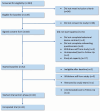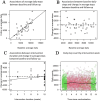Minimum effective dose of a multicomponent behaviour change intervention to increase the physical activity of individuals on primary statin therapy: an adaptive study using the time-to-event continual reassessment method (TiTE-CRM)
- PMID: 40764069
- PMCID: PMC12336609
- DOI: 10.1136/bmjopen-2024-090789
Minimum effective dose of a multicomponent behaviour change intervention to increase the physical activity of individuals on primary statin therapy: an adaptive study using the time-to-event continual reassessment method (TiTE-CRM)
Abstract
Objectives: To identify the minimum effective dose of a multi-behaviour change technique (BCT) intervention to increase physical activity among individuals on primary statin therapy using the time-to-event continual reassessment method (TiTE-CRM).
Setting: A large New York metropolitan area healthcare system comprising approximately 85 000 employees and 5.5 million patient encounters annually.
Participants: 42 participants enrolled in 13 cohorts of 3 participants, 1 cohort of 2 participants and 1 cohort of 1 participant. The sample was composed of 16.7% individuals aged 66 and older (n=7), 64.3% women (n=27), 69.0% white individuals (n=29) and 7.1% Hispanic individuals (n=3).
Interventions: A variable-duration, four-BCT text message intervention and a 2-week follow-up. Dose assignment relied on TiTE-CRM to adjust the duration of the intervention based on adherence of participants in prior cohorts. Five mechanisms of action (MoAs) were assessed: self-efficacy, intrinsic regulation, discrepancy in behaviour, motivation and barriers to activity.
Primary and secondary outcome measures: The primary outcome measure was the proportion of participants who achieved a 2000 step/day increase between baseline and follow-up. The secondary outcomes were within-participant changes in daily steps (examined as a continuous variable at the daily level) and potential MoAs for increased physical activity.
Results: Of the 40 participants who completed follow-up, 7 (17.5%) achieved the goal of 2000 or more steps per day during their follow-up period. Though participants did increase the number of steps they walked during the intervention (B(SE)=373.1 (154.7) steps; p=0.016), there was no association between increased intervention duration and increased daily average steps. The intervention was also associated with increases in self-efficacy (p=0.002), intrinsic regulation (p=0.037), discrepancy in behaviour (p<0.001) and motivation (p=0.039).
Conclusions: The results of this trial did not show a traditional dose-response curve to increasing the length of a multicomponent BCT intervention. Results did show that the intervention successfully increased steps during the intervention period and that the benefit of the intervention dwindled during follow-up. Further, potential MoAs for the intervention were confirmed.
Trial registration number: NCT05273723.
Keywords: Behavior; Cardiovascular Disease; Physical Fitness.
© Author(s) (or their employer(s)) 2025. Re-use permitted under CC BY-NC. No commercial re-use. See rights and permissions. Published by BMJ Group.
Conflict of interest statement
Competing interests: None declared.
Figures


Similar articles
-
Physical exercise training interventions for children and young adults during and after treatment for childhood cancer.Cochrane Database Syst Rev. 2013 Apr 30;(4):CD008796. doi: 10.1002/14651858.CD008796.pub2. Cochrane Database Syst Rev. 2013. Update in: Cochrane Database Syst Rev. 2016 Mar 31;3:CD008796. doi: 10.1002/14651858.CD008796.pub3. PMID: 23633361 Updated.
-
Falls prevention interventions for community-dwelling older adults: systematic review and meta-analysis of benefits, harms, and patient values and preferences.Syst Rev. 2024 Nov 26;13(1):289. doi: 10.1186/s13643-024-02681-3. Syst Rev. 2024. PMID: 39593159 Free PMC article.
-
Physical exercise training interventions for children and young adults during and after treatment for childhood cancer.Cochrane Database Syst Rev. 2016 Mar 31;3(3):CD008796. doi: 10.1002/14651858.CD008796.pub3. Cochrane Database Syst Rev. 2016. PMID: 27030386 Free PMC article.
-
Mobile phone messaging for preventive health care.Cochrane Database Syst Rev. 2012 Dec 12;12(12):CD007457. doi: 10.1002/14651858.CD007457.pub2. Cochrane Database Syst Rev. 2012. PMID: 23235643 Free PMC article.
-
Diet, physical activity and behavioural interventions for the treatment of overweight or obese children from the age of 6 to 11 years.Cochrane Database Syst Rev. 2017 Jun 22;6(6):CD012651. doi: 10.1002/14651858.CD012651. Cochrane Database Syst Rev. 2017. PMID: 28639319 Free PMC article.
References
-
- Mensah GA, Roth GA, Fuster V. The global burden of cardiovascular diseases and risk factors: 2020 and beyond. Washington, DC: American College of Cardiology Foundation; 2019. pp. 2529–32. - PubMed
Publication types
MeSH terms
Substances
Associated data
Grants and funding
LinkOut - more resources
Full Text Sources
Medical
